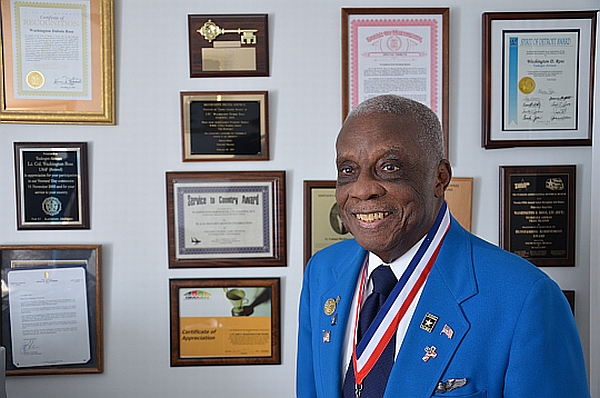The history of the Jeep® brand and the U.S. Military is well known.We thought it would be a good time to take a closer look at the Tuskegee Airmen. Jeep Blog sat down with Washington DuBois Ross, LTC, USAFRES, RET, a 93-year old veteran of the Tuskegee Airmen, for a first-hand account of his service.
Jeep Blog: Tell us a bit about growing up. Where are you from, and when did you first know you wanted to be a pilot?
Ross: I was born in Mound Bayou, Mississippi, the fourth son in a family of five boys and one girl. We moved to Ashland, Kentucky when was young. In Ashland they didn’t have an airport, just a field. I was 12-years old and the pilots would barnstorm, and one Sunday they announced you could take flights at noon. On Sundays you went to church so I missed the first round, but we got our pennies together for the second round of flights. They started the engines and it shook. I started to think maybe it wasn’t such a good idea, but it staggered into the air and circled Ashland, and I told my parents I wanted to be a pilot.
Jeep Blog: So where did you go from there, from knowing you wanted to be a pilot to actually flying?
Ross: I went to college at Hampton University in Virginia, where I was in the Civilian Pilot Training Program, which is where I received my pilot’s license. While I was in college, the U.S. knew war was coming, and Congress started training pilots in colleges. In 1940 I got a report from the local draft board and I was a senior so I got deferred. I planned to hide out in Ashland. Two weeks later I got another card. They’re on my trigger, I thought. I went to DC and it took them three more to weeks to find me. So I took the test on advanced aviation training. It was all whites when I went to take the test and they looked at me like a foreigner. While we waited for test results, everyone else was worried, like they’d struggled. So I pretended it was hard, I faked it, but I knew I had done well. Then I got the call for Tuskegee.
Jeep Blog: Could you tell us a bit about your training?
Ross: I arrived at Tuskegee as part of the class 43-I. In my class 42 started, 22 graduated. Actually, they needed instructors, and I could have taught but I wanted to be a fighter pilot – you’re young and crazy, you want to fly.
In 1943 I graduated as a Fighter Pilot with the rank of second lieutenant, and in October of 1943 we were sent to Selfridge Field in Michigan for overseas training. No one told me anything about P-40s. The first time I took off, I gave it throttle and looked down at the airspeed – 50, 60, 70, 80; we’re still on the ground. Good thing it was a long runway. I said to myself, now or never. I pulled back on the stick and up it went.
Funny story, we used to fly the P-40 over summer homes on Lake Huron. On the way home my engine fails. I went down, split two trees, and sheared off the wings. About 100 people came out from their homes. I’m wearing all my gear and they said, “Were you the one flying that thing?” I said “No.” [laughs] The worst part: I called the base and the asked, “Did you damage the plane?” No. [laughs]
Jeep Blog: What happened after training? Where did you serve?
Ross: The majority of my class joined the 332nd Fighter Group and left for the European Theater in December of 1943. Because of an unexpected hospitalization, however, I was unable to leave then, but followed later as part of a group of 10 replacements.
We traveled on a passenger ship that had been converted in order to carry troops. The ship was fast, and once we left the coast of the U.S., we continued on unescorted, the theory being that the ship was able to outrun enemy U-boats. I suppose that theory was right since we arrived safely in Oran, Algeria. After spending some time in North Africa, where we were to receive additional training (which we didn’t get), we were flown to Naples, Italy. There we joined the 332nd and from our base flew, P-39s, P-47s, and finally P-51s on long escort missions protecting bombers. The first mission was to capture Rome. We flew over to keep the Germans out, and that was the first time I’d seen the projectiles come out of the gun. Rome was declared an open city.
After 15 missions I got to go to rest camp in Naples but we snuck off to Rome and other cities to see the sites – there’s only so much can see from the air. Sightseeing in Pompeii is something. ‘How old are these buildings’ you wonder, ‘how did they build these things?’ The Coliseum is a sight.
I took off and landed 63 times. Missions were 4.5 hours total. Sometimes you’d fly solo, sometimes you would scatter. It was pretty scary flying over the Alps.
As the war wound down my squadron was disbanded, and since I had enough missions I was able to come home. I was overseas for almost a year.
Jeep Blog: What did you do after the war?
Ross: Stateside, I was assigned to Tuskegee Army Air Base in Alabama, this time as a twin-engine instructor for the B-25. When the Tuskegee base was closed we were transferred to Lockbourne Air Base in Ohio. In 1947 I was honorably discharged after serving four years on active duty. After being discharged from the service I worked for a year an auto company, and ten years as a clerk for the United States Postal Service. Then I spent twenty-nine years with the Detroit Board of Education as both a math teacher and a department head, retiring in 1984.
All the while, I was a member of the United States Air Force Reserves (USAFRES) where I served for twenty years. In 1981 I retired from USAFRES with the rank of Lieutenant Colonel. I earned the Air Medal, American Campaign Medal, EAME Medal, 1Star Rom Arno, 5 Oak Leaf, Clusters WWII Victory Medal, the Armed Forces Reserve Medal and the Congressional Gold Medal. I was inducted into the Kentucky Aviation hall of Fame November 12, 2011 in Lexington, Kentucky.
Jeep Blog: What about personally? How has retirement treated you?
Ross: My wife, Willie Pearl White (passed in 2003), and I have four children and three grandchildren. I am an active member of Tuskegee Airmen, Inc., and I am a member of the Speakers Bureau. I am a Life Member of the Reserve Officers Association. I belong to and am an active member of Berea Lutheran Church in Detroit, and an active member of the Detroit Chapter of the National Hampton Alumni Association, where I served as president as well as other offices. I like to travel and I like to listen to jazz and classical music.
For more information, visit tuskegeeairmennationalmuseum.org.


